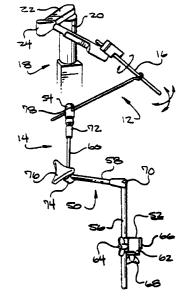Note: Claims are shown in the official language in which they were submitted.
CLAIMS
what is claimed is:
1. A pivot port that can support a surgical
instrument controlled by a robotic arm, comprising:
a pivot arm;
an adapter that has an aperture adapted to receive the
surgical instrument; and,
a first joint that couples said adapter to said pivot
arm.
2. The pivot port of claim 1, further comprising a
second joint that couples said adapter to said pivot arm.
3. The pivot port of claim 2, further comprising a
ring that supports said adapter and is coupled to said
first and second joints.
-13-
4. The pivot port of claim 3, wherein said adapter
includes a flange that is adjacent to an inner lip of said
ring.
5. A pivot port that can support a surgical instrument
controlled by a robotic arm, comprising:
a pivot arm; and,
a ball joint that is coupled to said pivot arm and has
an aperture adapted to receive the surgical instrument.
6. The pivot port of claim 5, wherein said ball joint
has a plurality of apertures.
7. The pivot port of claim 5, further comprising a
ring that is attached to said pivot arm and supports said
ball joint.
-14-
8. A medical system, comprising:
a pivot arm;
an adapter that has an aperture;
a first joint that couples said adapter to said pivot
arm;
a surgical instrument that extends through said
aperture of said adapter; and,
a robotic arm that can move said surgical instrument.
9. The system of claim 8, further comprising a second
joint that couples said adapter to said pivot arm.
10. The system of claim 8, further comprising a ring
that supports said adapter and is coupled to said first and
second joints.
-15-
11. The system of claim 10, wherein said adapter
includes a flange that is adjacent to an inner lip of said
ring.
12. The system of claim 8, further comprising a
support arm assembly that supports said pivot arm.
13. The system of claim 12, wherein said support arm
assembly includes a table mount, a support arm coupled to
said table mount and an end effector coupled to said
support arm and said pivot arm.
14. The system of claim 13, wherein said support arm
assembly includes a first linkage pivotally connected to
said table mount, a second linkage pivotally connected to
said first linkage, and a third linkage pivotally connected
to said second linkage and said end effector.
15. A medical system, comprising:
a pivot arm;
-16-
a ball joint that is coupled to said pivot arm and has
an adapter;
a surgical instrument that extends through said
aperture of said ball joint; and,
a robotic arm that can move said surgical instrument.
16. The system of claim 15, wherein said ball joint
has a plurality of apertures.
17. The system of claim 15, further comprising a ring
that is attached to said pivot arm and supports said ball
joint.
18. The system of claim 15, further comprising a
support arm assembly that supports said pivot arm.
19. The system of claim 18, wherein said support arm
assembly includes a table mount, an support arm coupled to
said table mount and an end effector coupled to said
support arm and said pivot arm.
-17-
20. The system of claim 19, wherein said support arm
assembly includes a first linkage pivotally connected to
said table mount, a second linkage pivotally connected to
said first linkage, and a third linkage pivotally connected
to said second linkage and said end effector.
21. A method for performing a medical procedure on a
patient, comprising:
creating an opening in the patient;
locating a pivot port adjacent to the opening in the
patient,
coupling a surgical instrument to the pivot port; and,
moving the surgical instrument with a robotic arm to
perform the medical procedure.
-18-
22. The method of claim 21, wherein the surgical
instrument is inserted through an aperture of an adapter of
the pivot port.
23. The method of claim 21, wherein the patient has an
open chest.
24. The method of claim 21, wherein the surgical
instrument is inserted through an aperture of a ball joint
of the pivot port.
-19-
